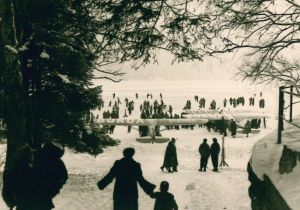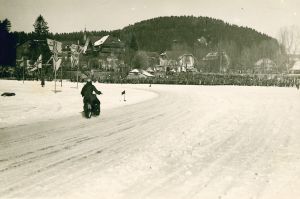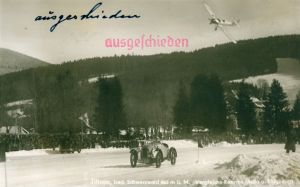TITEL (LFS01551 3) : Différence entre versions
| (6 révisions intermédiaires par le même utilisateur non affichées) | |||
| Ligne 19 : | Ligne 19 : | ||
|apercu=Titisee.png | |apercu=Titisee.png | ||
|lieuTournage=47.89753, 8.15478 | |lieuTournage=47.89753, 8.15478 | ||
| − | |Resume_de=Ausflug zum Titisee im Schwarzwald im Winter 1934. | + | |Resume_de=Ausflug zum Titisee im Schwarzwald im Winter 1934 mit spektakulärem Motorsportrennen. |
| + | |Resume_en=Excursion to Titisee in the Black Forest in the winter of 1934 with a spectacular motor sport race. | ||
|Description_de=ZT: Januar 1934 Buchheim-Titisee | |Description_de=ZT: Januar 1934 Buchheim-Titisee | ||
Drei junge Hunde auf einer Treppe, Spaziergang der Familie in verschneiter Landschaft, Menschenmenge betrachtet ein Autorennen in schneebedecktem Gelände, darüber fliegt Doppeldecker D -822, v.E. | Drei junge Hunde auf einer Treppe, Spaziergang der Familie in verschneiter Landschaft, Menschenmenge betrachtet ein Autorennen in schneebedecktem Gelände, darüber fliegt Doppeldecker D -822, v.E. | ||
| + | |Contexte_et_analyse_de=Der kurze stumme Schwarzweißfilm im 16mm Format dokumentiert die Ereignisse am Titisee-Buchheim im Januar 1934, wie ein Titel zu Beginn verrät. Die Bilder sind ohne Stativ frei aus der Hand gefilmt worden. Daher ist der Film etwas unruhig und zum Teil nicht richtig belichtet. Zu sehen ist erst ein kleines Mädchen, das bei strahlender Sonne mit drei Hundewelpen auf einer Steintreppe spielt. Dann schwenkt die Kamera von rechts nach links über eine winterliche Landschaft, die von schneebedeckten Wiesen und Bergen geprägt ist. Auf einem Pfad läuft eine Familie mit zwei Kindern auf eine Ortschaft zu mit einem alten Steinturm. Davor stehen ein Bauwagen und ein Auto. Die Familie läuft dann aus dem Dorf auf die Kamera zu. Die abschließende Szene zeigt in einer Totalen den mit Eis bedeckten Titisee im Schwarzwald. Dort findet ein Eisrennen mit Rennwagen und Motorrädern statt, die gegen Flugzeuge antreten. | ||
| + | |||
| + | [[Fichier:Titisee_4_StA_TN_260_106.jpg|vignette|Das Rennen lockte tausende Besucher (Foto: Stadtarchiv Titisee-Neustadt)]] | ||
| + | |||
| + | Mitten auf dem Eis ist deutlich die Rennstrecke erkennbar und am inneren Straßenrand sind Hakenkreuzfahnen gehisst. Darüber dreht ein Doppeldecker-Flugzeug seine Runden. Zu kleineren Gruppen haben sich Menschen auf dem Eis versammelt und blicken allesamt erwartungsvoll in dieselbe Richtung. Der Privatfilmer hat sich auf einem Hügel positioniert und dies ermöglicht ihm eine gute Perspektive auf die Geschehnisse, die er in einer Totalen festhält. Auf der Eisfläche des Titisees läuft die Verfolgungsjagd der Rennwagen und Motorräder mit Seitenwagen. Die Kamera dokumentiert das Geschehen und schwenkt nach links, wo weitere Zuschauer auf der Terrasse eines Hauses das Spektakel bestaunen. | ||
| + | |||
| + | [[Fichier:Titisee 2 StA TN 260 102.jpg|vignette|Die Rennen aus dem zugefrorenen Titisee waren eine Publikumsattraktion (Foto: Stadtarchiv Titisee-Neustadt)]] | ||
| + | |||
| + | Der Film erlaubt einen kurzen Blick auf das legendäre Eisrennen auf dem Titisee im Schwarzwald 1934. Diese Veranstaltungen konnten nur stattfinden, wenn der Winter kalt genug war, damit sich eine dicke Eisschicht auf dem Titisee bildete. Erstmals fand ein solches Rennen im Februar 1929 statt und mit Unterbrechungen bis 1935. Das publikumswirksame Ereignis lockte viele Menschen auf die eisbedeckte glitzernde Oberfläche des Sees. Die Veranstaltung gewann über die Jahre immer weiter an Popularität – der zugefrorene Titisee wurde zur Kulisse und zum Austragungsort eines wiederholten nervenaufreibenden Wettkampfs zwischen Autos, Motorrädern und Sportflugzeugen. | ||
| + | |||
| + | [[Fichier:Titisee 7 StA TN 260 201.jpg|vignette|Höhepunkt war das Wettrenen zwischen Autos, Motorrädern und Flugzeugen]] | ||
| + | |||
| + | Vom Freiburger Motorradclub wurde das Eisrennen 1929 gemeinsam in Kooperation mit dem Kurverein Titisee ins Leben gerufen. Von der Resonanz beeindruckt, beteiligte sich der ADAC in den darauffolgenden Jahren mit großem Erfolg an der Organisation der Veranstaltung. Bei strahlendem Sonnenschein versammelten sich die Schaulustigen zu Tausenden und 1934 kamen rund 15.000 Zuschauer aus Baden, Württemberg und dem Elsass. | ||
| + | Für die Teilnahmegebühr am Rennen und eine Übernachtung mit Frühstück verlangten die Veranstalter 10 Reichsmark. Die Besucher waren Tagesgäste und auch Wochenendreisende. Für das Befahren der vereisten Rennstrecke waren mit Nagelreifen ausgestattete Fahrzeuge notwendig. Gemeinsam mit den knatternden Motoren verursachten sie einen höllischen Lärm auf dem Eis. Die spannenden Wettkämpfe gewannen zunehmend an Dramatik und sorgten für eine hitzige Stimmung unter den Zuschauern. Die Piloten flogen entlang der Eispiste mit ihren Jagdfliegern wagemutige Manöver dicht über den Köpfen der Schaulustigen. Unbestrittener Höhepunkt war das spektakuläre Schaurennen zwischen Autos, Motorrädern und Flugzeugen. Bei dem Wettkampf galten für jede Fortbewegungsart eigene Regeln. Die Sportflieger sollten bei einer geringen Flughöhe sieben Runden um den Titisee absolvieren, für das Auto galten viereinhalb und mit dem Motorrad mussten drei Runden auf der glatten Seeoberfläche vollendet werden. | ||
| + | Das Rennen voller Nervenkitzel gewann der Motorradfahrer Roth, der zuvor mit seiner Leistung im Zweiradrennen überzeugt hatte. Ein weiterer Sieger der internationalen Eisrennen auf dem Titisee und wohl einer der bekanntesten Kunstflieger dieser Ära war Ernst Udet mit seinem Doppeldecker. Im Vergleichswettkampf lieferte er sich ein wahnwitziges Verfolgungsrennen mit einem Rennwagen. Auch außerhalb des Rennens sorgte der ehemalige Jagdflieger mit überaus riskanten Kunstflügen für Aufsehen. Das Motorsportevent gehörte bis 1935 zu den beliebtesten Winterveranstaltungen im Schwarzwald, wurde danach aber nicht mehr veranstaltet. | ||
| + | Ab Juni 1926 flog die Deutsche Luft Hansa AG, die spätere Lufthansa, täglich außer sonntags aus verschiedenen Städten über Stuttgart nach Freiburg. In der Saison 1929/1930 gehörte die Strecke Stuttgart-Freiburg zu den meist beflogenen im Deutschen Reich, denn sie brachte eine erhebliche Zeitersparnis gegenüber der Bahn und kostete mit 25 Reichsmark nur wenig mehr. Dadurch war der Schwarzwald für die Städter nur einen Katzensprung entfernt, was das Reisen ankurbelte. Für die Touristen bot die Lufthansa zusätzlich Rundflüge über das Feldberggebiet und den südlichen Schwarzwald an. Im Winter wurde auf dem zugefrorenen Titisee gestartet und gelandet, der so zu einem improvisierten Flugplatz wurde. | ||
| + | Heute zieht der in 800 Metern Höhe gelegene, idyllische Titisee auch ohne winterliche Veranstaltungen bis zu 2 Mio. Besucher im Jahr an. Statt schnelle Fortbewegungsmittel, tummeln sich nun Wanderer, Fußgänger und Eisläufer auf dem zugefrorenen Titisee im Schwarzwald – wenn der Winter kalt genug ist. | ||
| + | Mazlum Altan | ||
| + | |Contexte_et_analyse_en=The short, silent black and white film in 16mm format documents the events at Titisee-Buchheim in January 1934, as a title reveals at the beginning. The pictures were filmed by hand without a tripod. Therefore, the film is a bit restless and partly not properly exposed. First you can see a little girl who is playing with three puppies on a stone staircase in the bright sun. Then the camera pans from right to left over a wintry landscape characterized by snow-covered meadows and mountains. A family with two children is walking on a path towards a village with an old stone tower. In front of it are a construction trailer and a car. The family then walks out of the village towards the camera. The final scene shows the ice-covered Titisee in the Black Forest in a long shot. There is an ice race with racing cars and motorcycles that compete against planes. | ||
| + | |||
| + | [[Fichier:Titisee_4_StA_TN_260_106.jpg|vignette|The races on the frozen Titisee attracted thousands of spectators (Foto: Stadtarchiv Titisee-Neustadt 260_106)]] | ||
| + | |||
| + | In the middle of the ice the racetrack is clearly recognizable and swastika flags are hoisted on the inner roadside. A double-decker airplane is making its laps above it. People have gathered in smaller groups on the ice and are all looking expectantly in the same direction. The private filmmaker has positioned himself on a hill and this gives him a good perspective of the events, which he captures in a long shot. The chase of racing cars and motorcycles with sidecars takes place on the ice surface of Lake Titisee. The camera documents what is happening and pans to the left, where other spectators marvel at the spectacle on the terrace of a house. | ||
| + | |||
| + | [[Fichier:Titisee 2 StA TN 260 102.jpg|vignette|The races were a challenge for people and machines (Foto: Stadtarchiv Titisee-Neustadt 260 102)]] | ||
| + | |||
| + | The film allows a brief glimpse of the legendary ice race on the Titisee in the Black Forest in 1934. These events could only take place when the winter was cold enough for a thick layer of ice to form on the Titisee. Such a race took place for the first time in February 1929 and with interruptions until 1935. The popular event attracted many people to the ice-covered, glittering surface of the lake. The event grew in popularity over the years - the frozen Titisee became the backdrop and venue for repeated nerve-wracking competitions between cars, motorcycles and sports aircraft. | ||
| + | The ice race was launched in 1929 by the Freiburg motorcycle club in cooperation with the Titisee spa association. Impressed by the response, the ADAC participated in the organization of the event with great success in the following years. In bright sunshine, the bystanders gathered in their thousands and in 1934 around 15,000 spectators came from Baden, Württemberg and Alsace. | ||
| + | [[Fichier:Titisee 7 StA TN 260 201.jpg|vignette|Highlight were the races with cars and motorcycles against airplanes (Foto: Stadtarchiv Titisee-Neustadt 260 201)]] | ||
| + | |||
| + | The organizers demanded 10 Reichsmarks for the participation fee in the race and an overnight stay with breakfast. The visitors were day visitors and also weekend travelers. Vehicles equipped with nailed tires were necessary to drive on the icy racetrack. Together with the roaring engines, they made a hell of a noise on the ice. The exciting competitions became increasingly dramatic and created a heated atmosphere among the spectators. The pilots flew daring maneuvers along the ice runway with their fighter pilots just above the heads of the onlookers. The undisputed highlight was the spectacular show race between cars, motorcycles and airplanes. During the competition, there were separate rules for each type of locomotion. The sports pilots were supposed to complete seven laps around the Titisee at a low altitude, four and a half for the car and three laps on the smooth lake surface with the motorcycle. | ||
| + | |||
| + | The race full of thrills was won by motorcyclist Roth, who had previously impressed with his performance in two-wheel races. Another winner of the international ice races on the Titisee and probably one of the most famous stunt pilots of this era was Ernst Udet with his double-decker. In the comparison competition, he delivered a crazy chase with a racing car. Even outside of the race, the former fighter pilot caused a sensation with extremely risky aerobatics. The motorsport event was one of the most popular winter events in the Black Forest until 1935, but was no longer held afterwards. | ||
| + | From June 1926, Deutsche Luft Hansa AG, later Lufthansa, flew daily except Sundays from various cities via Stuttgart to Freiburg. In the 1929/1930 season, the Stuttgart-Freiburg route was one of the most frequently flown routes in the German Reich, as it saved considerable time compared to the train and cost only a little more at 25 Reichsmarks. As a result, the Black Forest was only a stone's throw away for the city dwellers, which stimulated travel. For the tourists, Lufthansa also offered sightseeing flights over the Feldberg area and the southern Black Forest. In winter, take-off and landing took place on the frozen Titisee, which thus became an improvised airfield. | ||
| + | |||
| + | Today the idyllic Titisee, located at an altitude of 800 meters, attracts up to 2 million visitors a year even without winter events. Instead of fast means of transport, now hikers, pedestrians and ice skaters cavort on the frozen Titisee in the Black Forest - if the winter is cold enough. | ||
| + | |||
| + | Mazlum Altan | ||
| + | |Bibliographie=Autorennen Titisee: https://sagenhafterschwarzwald.blogspot.com/search?q=Autorennen; https://www.hochschwarzwald.de/Reisemagazin/Alle-Geschichten/Historie/Heisse-Oefen-auf-dem-Glatteis (konsultiert 15.1.2021); Stadtarchiv Titisee/Neustadt: https://www.titisee-neustadt.de/pb/site/Titisee-Neustadt/node/1995256/stadtarchiv.html (konsultiert 15.1.2021); Wintersport Schwarzwald: https://www.hochschwarzwald.de/Reisemagazin/Alle-Geschichten/Historie/Heimat-des-Skilaufs-Teil-II (konsultiert 15.1.2021). | ||
}} | }} | ||
Version actuelle datée du 9 mars 2021 à 14:18
Résumé
Description
ZT: Januar 1934 Buchheim-Titisee
Drei junge Hunde auf einer Treppe, Spaziergang der Familie in verschneiter Landschaft, Menschenmenge betrachtet ein Autorennen in schneebedecktem Gelände, darüber fliegt Doppeldecker D -822, v.E.
Contexte et analyse
The short, silent black and white film in 16mm format documents the events at Titisee-Buchheim in January 1934, as a title reveals at the beginning. The pictures were filmed by hand without a tripod. Therefore, the film is a bit restless and partly not properly exposed. First you can see a little girl who is playing with three puppies on a stone staircase in the bright sun. Then the camera pans from right to left over a wintry landscape characterized by snow-covered meadows and mountains. A family with two children is walking on a path towards a village with an old stone tower. In front of it are a construction trailer and a car. The family then walks out of the village towards the camera. The final scene shows the ice-covered Titisee in the Black Forest in a long shot. There is an ice race with racing cars and motorcycles that compete against planes.
In the middle of the ice the racetrack is clearly recognizable and swastika flags are hoisted on the inner roadside. A double-decker airplane is making its laps above it. People have gathered in smaller groups on the ice and are all looking expectantly in the same direction. The private filmmaker has positioned himself on a hill and this gives him a good perspective of the events, which he captures in a long shot. The chase of racing cars and motorcycles with sidecars takes place on the ice surface of Lake Titisee. The camera documents what is happening and pans to the left, where other spectators marvel at the spectacle on the terrace of a house.
The film allows a brief glimpse of the legendary ice race on the Titisee in the Black Forest in 1934. These events could only take place when the winter was cold enough for a thick layer of ice to form on the Titisee. Such a race took place for the first time in February 1929 and with interruptions until 1935. The popular event attracted many people to the ice-covered, glittering surface of the lake. The event grew in popularity over the years - the frozen Titisee became the backdrop and venue for repeated nerve-wracking competitions between cars, motorcycles and sports aircraft. The ice race was launched in 1929 by the Freiburg motorcycle club in cooperation with the Titisee spa association. Impressed by the response, the ADAC participated in the organization of the event with great success in the following years. In bright sunshine, the bystanders gathered in their thousands and in 1934 around 15,000 spectators came from Baden, Württemberg and Alsace.
The organizers demanded 10 Reichsmarks for the participation fee in the race and an overnight stay with breakfast. The visitors were day visitors and also weekend travelers. Vehicles equipped with nailed tires were necessary to drive on the icy racetrack. Together with the roaring engines, they made a hell of a noise on the ice. The exciting competitions became increasingly dramatic and created a heated atmosphere among the spectators. The pilots flew daring maneuvers along the ice runway with their fighter pilots just above the heads of the onlookers. The undisputed highlight was the spectacular show race between cars, motorcycles and airplanes. During the competition, there were separate rules for each type of locomotion. The sports pilots were supposed to complete seven laps around the Titisee at a low altitude, four and a half for the car and three laps on the smooth lake surface with the motorcycle.
The race full of thrills was won by motorcyclist Roth, who had previously impressed with his performance in two-wheel races. Another winner of the international ice races on the Titisee and probably one of the most famous stunt pilots of this era was Ernst Udet with his double-decker. In the comparison competition, he delivered a crazy chase with a racing car. Even outside of the race, the former fighter pilot caused a sensation with extremely risky aerobatics. The motorsport event was one of the most popular winter events in the Black Forest until 1935, but was no longer held afterwards. From June 1926, Deutsche Luft Hansa AG, later Lufthansa, flew daily except Sundays from various cities via Stuttgart to Freiburg. In the 1929/1930 season, the Stuttgart-Freiburg route was one of the most frequently flown routes in the German Reich, as it saved considerable time compared to the train and cost only a little more at 25 Reichsmarks. As a result, the Black Forest was only a stone's throw away for the city dwellers, which stimulated travel. For the tourists, Lufthansa also offered sightseeing flights over the Feldberg area and the southern Black Forest. In winter, take-off and landing took place on the frozen Titisee, which thus became an improvised airfield.
Today the idyllic Titisee, located at an altitude of 800 meters, attracts up to 2 million visitors a year even without winter events. Instead of fast means of transport, now hikers, pedestrians and ice skaters cavort on the frozen Titisee in the Black Forest - if the winter is cold enough.
Mazlum AltanBibliographie
- ↑ Cette fiche est en cours de rédaction. À ce titre elle peut être inachevée et contenir des erreurs.








